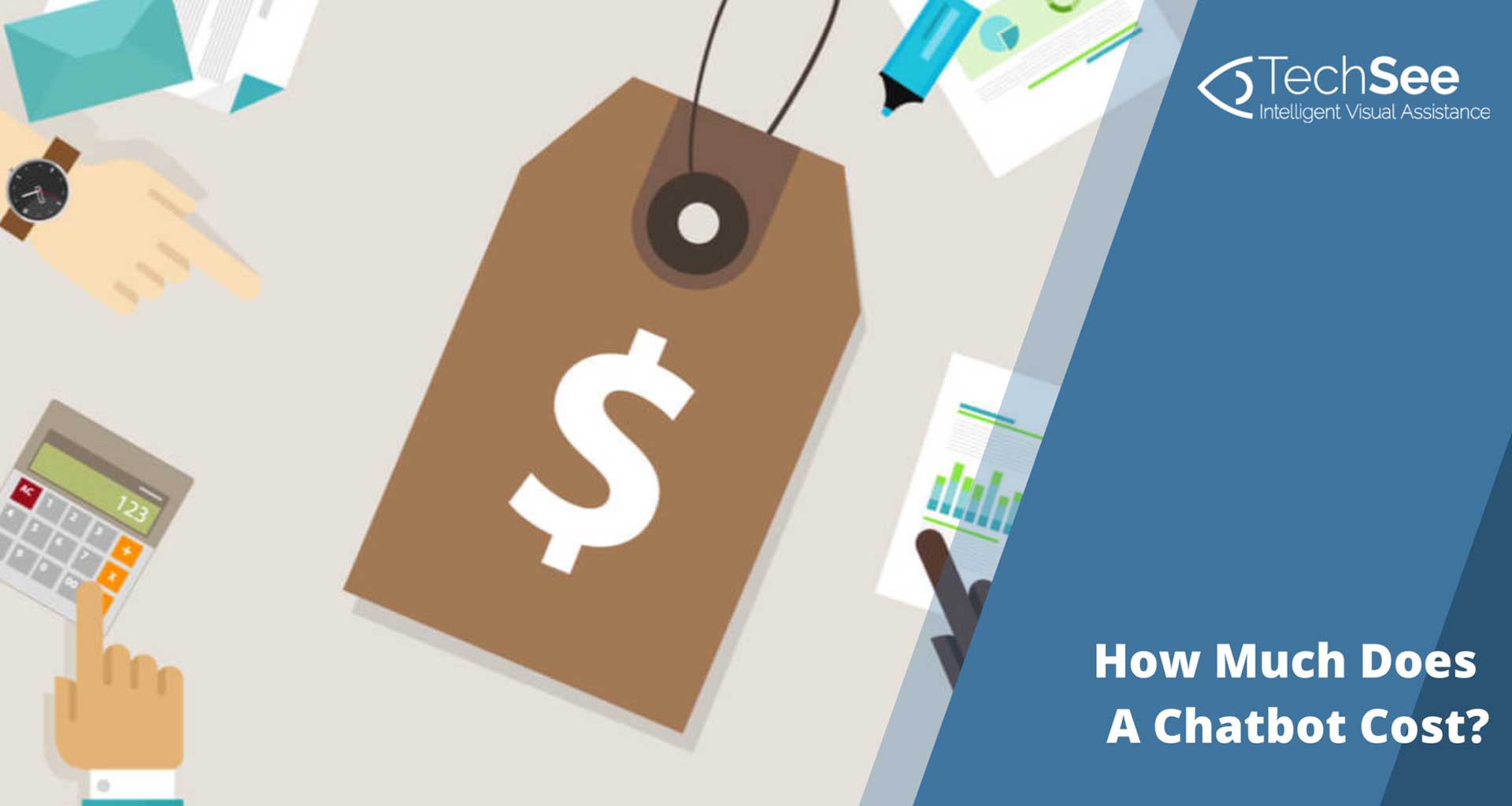Contents
- The Risks of Chatbot Technology for Businesses
- How to Justify the Chatbot Investment
- Chatbot Cost Benefit Analysis
- 3 Common Chatbot Cost Models
- The Pitfall Common Chatbot Pricing Models
- An Alternative Chatbot Pricing Model: Performance-Based
- Comparing Chatbot Pricing Models
- Eyes Open to the Future with the Best Chatbot Cost Structure
Conversational AI platforms, known as virtual assistants or chatbots, represent a promising technology that is already projected to reduce customer service costs and cut business expenses by as much as $8 billion in less than five years. However, despite the transformative revolution and the promise it brings, chatbots are not mature enough yet for businesses to fully rely on them to perform all tasks. TechSee explores the key formula for analyzing how much a chatbot costs and explores new performance-based pricing.
The Risks of Chatbot Technology for Businesses
Setting a budget for a new technology is always delicate, but for customer-facing conversational AI platforms, it is even more challenging as chatbot risks are great. Here are a few considerations companies should take when implementing chatbot technology:
- Will the technology be accurate or will the bot’s errors make the company look unprofessional?
- Will the chatbot be effective or will customers need to be transferred to a human agent anyway?
- How long will it take until the customers accept the new technology?
- What if the technology is too effective and the associated costs are higher than expected?
How to Justify the Chatbot Investment
Despite the chatbot risks of them not being fully reliable, forward-thinking businesses, from small startups to large enterprises, recognize the potential benefits of investing in chatbot technology to support self-service strategy. The decision to move forward is typically determined based on a number of factors, such as:
- target audience
- required activities
- specific business needs, and
- price (often the most important factor)
Chatbot Cost Benefit Analysis
The potential financial value of implementing virtual assistants is clear. After all, a standard interaction with a chatbot generally costs less than $1. If that interaction can replace a live communication with the call center, which costs $10-12 on average, or help avoid a technician dispatch, which could cost $150, the savings are obvious.
However, the efficiency of conversational AI platforms will not be seamless from the start. If out of 10 interactions with chatbots, four customers terminate the chat in frustration, three are escalated to a live agent, two offer the customer erroneous information, and one is successfully solved by the bot, then they haven’t achieved the desired end result.
The cost involved with taking repeat calls or lowered NPS is simply not worth the amount saved on the few interactions the bot is able to handle independently.
This cost benefit analysis of chatbots is being studied by CX and customer service departments in call centers around the world.
3 Common Chatbot Cost Models
What is the optimal model to use when adopting chatbot technologies that will ensure minimal financial risk?
Today’s chatbot developers typically offer a pricing model that encompasses each of the following three components:
Development and Implementation Fee
Companies pay a hefty one-time charge that includes project management, UX design, software customization, testing, infrastructure setup, implementation, and training the model’s algorithms.
Subscription-based Fee
Companies pay a recurring monthly fee which entitles them to access resources such as storage, engines, updates, and support. Fees vary based on the following factors:
- number of active users
- hosting requirements
- chatbot complexity, and
- 3rd party integrations needed.
Consumption-based fee
Companies pay a sliding-scale fee based on the number of sessions that the virtual assistant has with customers. Per session fees range from a few cents to $2 each. While the first two components are fixed, this element is dynamic.
By combining elements of these three models to work out how much a chatbot costs, a win-win situation should emerge. The vendor ensures that the development and chatbot implementation costs are paid even in the event that the project is suspended or the technology is not adopted. In addition, the company benefits from a flexible pricing model that is easier to swallow.
The Pitfall Common Chatbot Pricing Models
In practice, companies find it difficult to reach the optimal balance between these three chatbot pricing elements, and even harder to evaluate in advance the bottom-line cost of conversational AI technology. Businesses, in all stages of maturity, are being asked to dedicate budgets in a reality where technology is not mature enough, and its adoption and potential short term ROI are unknown.
Some enterprises find it hard to justify a ‘chatbot implementation cost’ before knowing whether the chatbot will be adopted successfully. On the other hand, some organizations are wary of locking themselves into a long-term recurring subscription.
There are also others who prefer to avoid the consumption-based model. This is because of its potential to escalate costs unexpectedly if adoption is faster than anticipated, leading them to become victims of their own success. Similarly, they fear high consumption costs for sessions that are only partially successful or even worse, totally unsuccessful.
An Alternative Chatbot Pricing Model: Performance-Based
In light of the challenges involved with the common chatbot pricing models, new innovative models have emerged that focus more on ensuring the enterprise’s success. These new models make it possible for businesses to more easily digest how much a chatbot costs due to the minimized risk.
Here are some examples of success-based chatbot pricing models that have been making a splash in the market:
Successful Consumption Model
This model is similar to the traditional consumption-based model where the customer pays a fixed price per session with a bot, but with an important twist. In this innovative model, the customer is charged only for successful sessions, with success defined through a number of variable options.
For example, one means of measuring success is if the conversation reaches a point where the customer receives a thank you page, or a survey link. This ensures that the customer has not bounced out of the session before completion.
Contingency Model
In this model, success is tied directly with the value generated from the conversation. For example, an enterprise will pay only when a technician dispatch or a call to a human agent was avoided. Another scenario is when success is tied with customer satisfaction; if the NPS score or survey results are positive, then the enterprise pays.
This model is becoming more and more common in the BPO domain, where the entire industry is shifting to success-based invoicing. If contingencies become the standard in agent outsourcing, it may be only a matter of time until it becomes a common model for virtual assistants as well.
Pay per Box
With this model, the enterprise pays a set fee based on the number of products or services sold to customers. For example, for every $50 set-top box a telecommunications company sells, it will pay the bot vendor $1 to support the device, regardless of how many sessions are generated. In this sense, the chatbot cost becomes part of the product package; right alongside the user manual.
In a service-based industry, for example, a utility may pay a set price per subscriber to its premium service.
Comparing Chatbot Pricing Models
When focusing on a chatbot cost benefit analysis, it is worthwhile comparing the various pricing structures, as discussed in detail above.
| COMMON CHATBOT COST MODELS | ALTERNATIVE CHATBOT COST MODELS |
|---|---|
| Development and implementation fee | Successful consumption model |
| Subscription-based fee | Contingency model |
| Consumption-based fee | Pay per box |
Eyes Open to the Future with the Best Chatbot Cost Structure
Answering the question of are chatbots worth it and assessing the financial value of conversational AI platforms, an emerging and promising technology, is complicated. It’s relatively new, and its success and maturity have yet to be fully proven.
While a number of models addressing how much a chatbot costs are currently available, all entail a risk on the part of the enterprise. The key to facilitating the widespread adoption of virtual assistants is to formulate an optimal chatbot cost structure. This will support the enterprise in achieving success with the technology.






